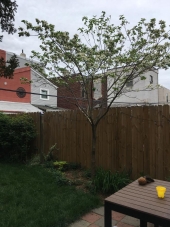
 2
2




Maybe Life is always like being on a trapeze or a tightrope at the circus...
 3
3









Maybe Life is always like being on a trapeze or a tightrope at the circus...

 2
2








Maybe Life is always like being on a trapeze or a tightrope at the circus...




greg mosser wrote:we’ve got a couple acres of chestnuts growing in dense clay soil on what was a badly overgrazed pasture....i don’t recognize the issue you’re describing (delayed leafing out?)...but it’s definitely possible to grow chestnuts in heavier soil. don’t know what to recommend. the main thing that sticks out to me is watering. beyond the initial planting, how much did they get watered? were these potted or bareroot? also, top dressing with compost (under mulch is best) may be better than compost in the hole, especially in clay - you don’t want a super-rich little space that the tree isn’t motivated to reach out from.
the main danger in clay soils is digging a hole that doesn’t drain water well. how big were the holes compared to what was planted? was the soil packed down?
i think an advantage of our planting here was that it was from seed. small holes with original soil packed in on top. there was no way for the holes to become soup pots. they were slow to grow the first couple years but have been picking up steam as the used-to-be-pasture heals. our main danger is deer browse.












Han Kop wrote:I don't see a reason for replanting them
What is your soil ph.
Chestnuts on clay is a bad idea to start with. If its also basic soil you can forget it. They like acid. They like slopes, well draining soil, fertile sandy loam.
Maybe Life is always like being on a trapeze or a tightrope at the circus...








Maybe Life is always like being on a trapeze or a tightrope at the circus...
 1
1




Brody Ekberg wrote:Thanks for the response, and I agree, I totally need to quit worrying. I found out yesterday that they are seedlings, not grafted, so all the suckers are true to type. Also, the nursery I got them from said they are hardy to at least -30, but we got a little colder than that last winter and damage is expected.
As of now, here’s my plan: pull the weeds, put a thin paper and woodchip mulch layer and wait until fall. Once the trees are dormant, I’ll prune off whatever is dead and either prune off the suckers for a new leader, or leave the suckers for a bushier tree. Also, depending on how they fare this summer, I may replant them in the fall once they are dormant. But if this summer goes well for them I may just leave them as is. My biggest concern is root rot, but I’ll be very sparing with mulch and water and hope for the best.




Mark Beard wrote:
Brody,
It’s been a few years…. How did the Chestnut trees come along since you posted?

|
Sunglasses. AKA Coolness prosthetic. This tiny ad doesn't need shades:
Rocket Mass Heater Resources Wiki
https://permies.com/w/rmh-resources
|




